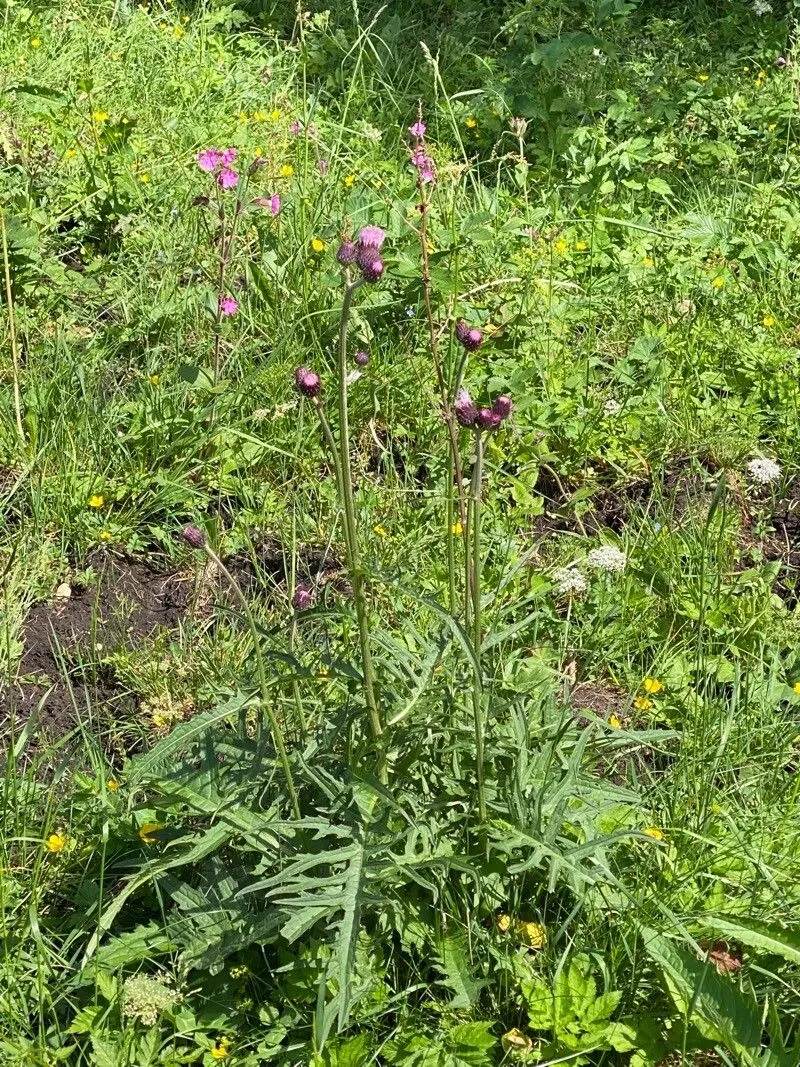
Author: All.
Bibliography: (1789). Auct. Fl. Pedem.
Year: 1789
Status: accepted
Rank: species
Genus: Cirsium
Vegetable: False
Observations: Europe
The Brook thistle, scientifically known as Cirsium rivulare, is a striking and unique plant native to Europe. Belonging to the Asteraceae family, which is renowned for its diversity and the multitude of beautiful and useful species it encompasses, the Brook thistle is a notable member of this extensive botanical group.
This perennial plant thrives in moist environments, often found in wetlands, stream banks, and other damp areas, reflecting its common name that ties it to brook-side habitats. The Brook thistle typically features erect stems which can reach a substantial height, crowned with clusters of striking deep reddish-purple flower heads. These flowers are particularly attractive to a wide variety of pollinators, including bees and butterflies, making Cirsium rivulare an excellent plant for those aiming to enhance the biodiversity of their gardens or natural spaces.
The leaves of Brook thistle are another distinctive feature, with their spiny, serrated edges and vibrant green hues, providing a textural contrast to the more common foliage found in many garden settings. Despite its somewhat formidable appearance, the plant’s robust nature and resilience make it an outstanding choice for gardeners looking for hardy yet visually appealing additions to their gardens.
First described in 1789 in “Auct. Fl. Pedem.” by All., the Brook thistle has since been recognized for both its ornamental value and ecological importance. This plant is not only a visual delight but also plays a vital role in supporting local wildlife. It helps in maintaining a healthy ecosystem by offering food and habitat to various insects and birds.
In summary, Cirsium rivulare is a captivating and essential component of the European flora. Its lush, spiked foliage coupled with the vibrant rosettes of flowers make it a standout choice for naturalistic garden designs, while its ecological benefits underscore its importance in maintaining biodiversity. Whether used in wetland restoration projects or as a feature in garden ponds and water features, Brook thistle proves to be an invaluable and versatile plant.
Swe: aftonstjärna, mörk pärlhyacint, pärlhyacint, spärrmorgonstjärna, bäcktistel
Dan: almindelig perlehyacint, nikkende fuglemælk
Deu: bach-kratzdistel
Fin: hentohelmililja, nuokkutähdikki
Nor: nikkestjerne, perleblom
Eng: brook thistle
Nob: bekketistel
Nno: bekketistel
En: Brook Thistle
Be: Бадзяк рачны
Ca: Cardigassa rivular
Cs: Pcháč potoční
Da: Almindelig Perlehyacint, Nikkende Fuglemælk
Nl: Oeverdistel
Fi: Puro-ohdake, Hentohelmililja, Nuokkutähdikki
Fr: Cirse des ruisseaux, Cirse de Salzbourg
De: Bach-Kratzdistel
Hu: Csermelyaszat
It: Cardo dei rivi
No: Nikkestjerne, Perleblom
Nb: Bekketistel
Nn: Bekketistel
Pl: Ostrożeń łąkowy
Sv: Bäcktistel, Aftonstjärna, Mörk pärlhyacint, Pärlhyacint, Spärrmorgonstjärna
: Brook thistle
Taken Aug 14, 2022 by Robert Drajewicz (cc-by-sa)
Taken Jun 26, 2021 by etienne copeaux (cc-by-sa)
Taken Jul 8, 2021 by margarida vila (cc-by-sa)
Taken Jun 20, 2018 by Natacha Gillet (cc-by-sa)
Taken Jun 17, 2018 by Jean-Claude Buffaz (cc-by-sa)
Taken Nov 8, 2022 by David Hocken (cc-by-sa)
Taken Nov 8, 2022 by David Hocken (cc-by-sa)
Taken Jun 27, 2022 by F. Manzano (cc-by-sa)
Taken Jul 14, 2020 by Llandrich anna (cc-by-sa)
Taken Jul 8, 2021 by margarida vila (cc-by-sa)
Taken Jun 14, 2022 by Jacques Zuber (cc-by-sa)
Taken Jul 4, 2018 by Tela Botanica − Liliane Roubaudi (cc-by-sa)
Taken Jul 1, 2016 by Tela Botanica − Yoan MARTIN (cc-by-sa)
Taken Jul 1, 2016 by Tela Botanica − Yoan MARTIN (cc-by-sa)
Taken Jun 28, 2016 by Tela Botanica − Yoan MARTIN (cc-by-sa)
Taken Jun 1, 2022 by Sylvain Piry (cc-by-sa)
Taken Jul 14, 2020 by Llandrich anna (cc-by-sa)
Taken Nov 8, 2022 by David Hocken (cc-by-sa)
Taken Jul 6, 2021 by Llandrich anna (cc-by-sa)
Taken May 19, 2022 by Fero Looxi (cc-by-sa)
Taken Jul 22, 2020 by beurny (cc-by-sa)
Taken Jun 30, 2021 by hanne stawarz (cc-by-sa)
Taken Jul 4, 2018 by Tela Botanica − Liliane Roubaudi (cc-by-sa)
Taken Jan 1, 1970 by Photoflora – L’Abbé COSTE (©)
Taken Jul 15, 2019 by Photoflora – Jean-Luc TASSET (©)
Taken Aug 15, 2010 by Photoflora – Benoit BOCK (©)
Taken Jun 28, 2016 by Tela Botanica − Yoan MARTIN (cc-by-sa)
© copyright of the Board of Trustees of the Royal Botanic Gardens, Kew.
Ph maximum: 7.0
Ph minimum: 6.5
Light: 7
Atmospheric humidity: 8
Soil nutriments: 6
Family: Myrtaceae Author: (F.Muell.) K.D.Hill & L.A.S.Johnson Bibliography: Telopea 6: 402 (1995) Year: 1995 Status:…
Family: Rubiaceae Author: Pierre ex A.Froehner Bibliography: Notizbl. Bot. Gart. Berlin-Dahlem 1: 237 (1897) Year:…
Family: Sapindaceae Author: Koidz. Bibliography: J. Coll. Sci. Imp. Univ. Tokyo 32(1): 38 (1911) Year:…
Family: Asteraceae Author: A.Gray Bibliography: Pacif. Railr. Rep.: 107 (1857) Year: 1857 Status: accepted Rank:…
Family: Fabaceae Author: Medik. Bibliography: Vorles. Churpfälz. Phys.-Ökon. Ges. 2: 398 (1787) Year: 1787 Status:…
Family: Aspleniaceae Author: (Cav.) Alston Bibliography: Bull. Misc. Inform. Kew 1932: 309 (1932) Year: 1932…